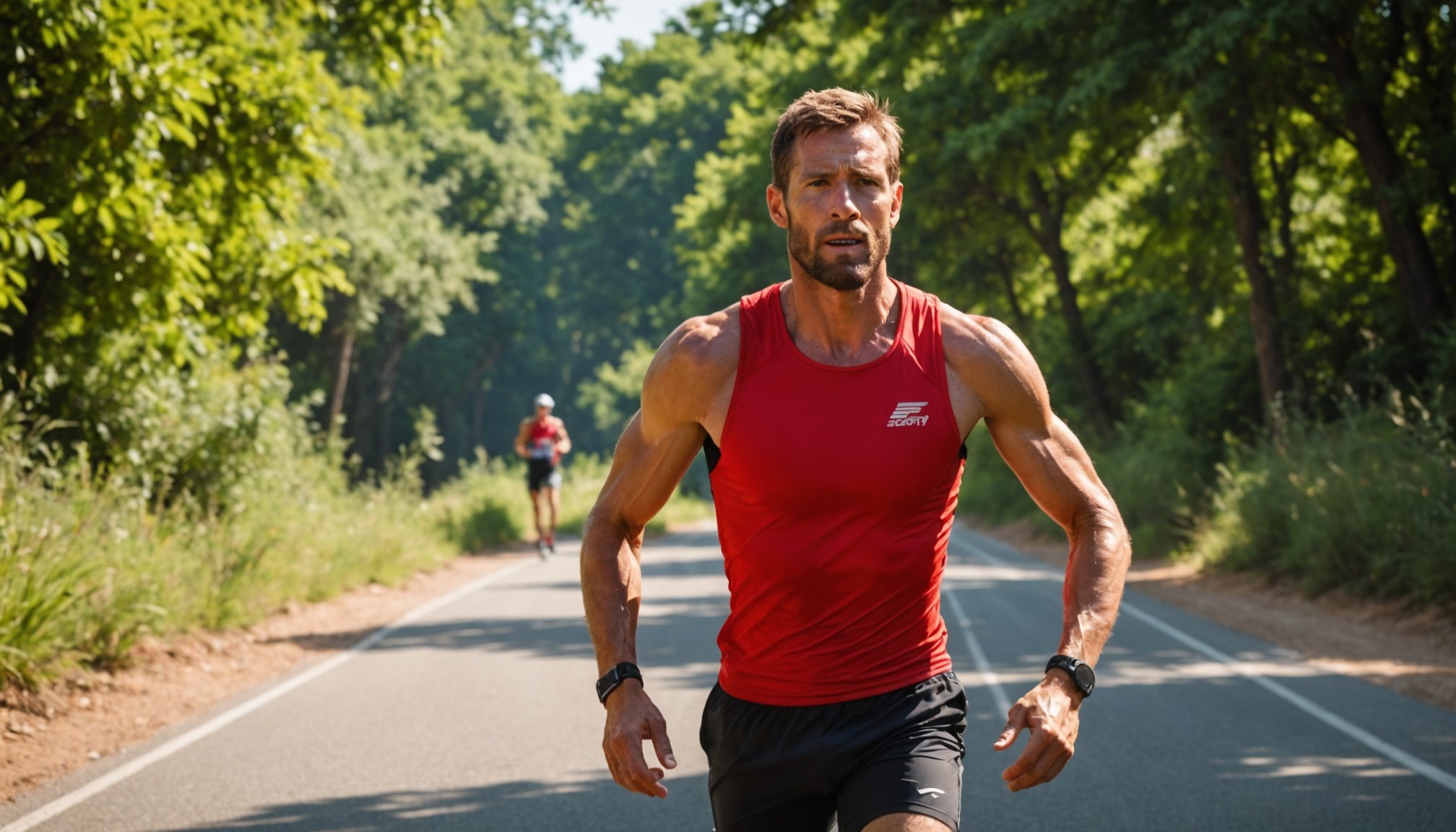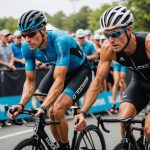Top Proven Techniques to Combat Heat Stress in Endurance Athletes
When it comes to endurance sports, particularly those conducted in hot and humid conditions, heat stress is a significant concern that can severely impact an athlete’s performance and health. Here, we will delve into the top proven techniques that endurance athletes can use to combat heat stress, ensuring they stay safe and perform at their best.
Understanding Heat Stress
Before we dive into the techniques, it’s crucial to understand what heat stress is and how it affects the body. Heat stress occurs when the body’s ability to cool itself is overwhelmed, leading to a rise in core body temperature. This can result in various heat-related illnesses, ranging from mild heat exhaustion to life-threatening heatstroke.
This might interest you : Top Recovery Strategies to Combat Muscle Fatigue in Ultracycling: Your Ultimate Guide
The Science Behind Heat Stress
In hot and humid environments, such as those encountered during the Diagonale des Fous ultra-trail on the island of La Réunion, the body’s primary cooling mechanism, sweating, is less effective. High humidity prevents sweat from evaporating efficiently, reducing the body’s ability to cool down. This situation can lead to dehydration and hyperthermia, as the body struggles to maintain its internal temperature[1].
Heat Acclimation
One of the most effective ways to combat heat stress is through heat acclimation. This process involves gradually exposing the body to hot conditions over a period of time to enhance its ability to cool itself.
In parallel : Enhancing Fencing Performance: Proven Tactical Training Techniques to Boost Your Reaction Times
How Heat Acclimation Works
Heat acclimation typically takes two to three weeks of regular exposure to hot environments. During this period, the body adapts by increasing its sweat rate and reducing the amount of salt in sweat, which helps preserve essential electrolytes for muscle function. This adaptation also includes an increase in plasma volume, which improves the body’s ability to transport heat from the core to the skin surface[1].
Hydration Strategies
Proper hydration is critical for athletes competing in hot weather. Here are some key strategies to ensure adequate hydration:
Frequent Hydration
- Athletes should drink water and electrolyte-rich fluids regularly, even before feeling thirsty. This is especially important in high-humidity environments where sweat evaporation is impaired.
- Aim to drink at least 0.19 liters of fluid per kilometer run to replace lost sweat and electrolytes[1].
Electrolyte Balance
- In addition to water, athletes must consume electrolytes to prevent hydric imbalances and muscle cramps.
- Sports drinks or electrolyte supplements can help maintain the balance of sodium, potassium, and other essential minerals.
Monitoring Hydration
- Athletes should monitor their urine color to ensure they are well-hydrated. Dark yellow or amber-colored urine can indicate dehydration.
- Weighing oneself before and after exercise can also help track fluid loss.
Cooling Techniques
Besides hydration, several cooling techniques can help athletes manage their body temperature during hot weather.
Use of Cooling Gear
- Wearing lightweight, breathable clothing can help improve airflow and sweat evaporation.
- Using cooling towels, bandanas, or even cooling vests can lower skin temperature and provide relief.
Rest and Shade
- Taking frequent breaks in shaded areas can significantly reduce heat exposure.
- Reducing exercise intensity during the hottest parts of the day can also help prevent overheating.
Nutrition and Energy Management
Proper nutrition and energy management are vital for maintaining performance in hot conditions.
Balanced Diet
- A balanced diet rich in carbohydrates, proteins, and healthy fats provides the necessary energy for endurance activities.
- Including electrolyte-rich foods such as bananas (potassium) and avocados (potassium) can help maintain electrolyte balance.
Energy Gels and Bars
- During long events, consuming energy gels and bars can provide quick energy boosts.
- However, these should be consumed with water to avoid dehydration.
Mental Preparation
Mental preparation is often overlooked but is crucial for managing heat stress.
Visualization and Focus
- Techniques like visualization, where athletes imagine themselves performing well in hot conditions, can help build mental resilience.
- Focusing on the task at hand and breaking down the event into manageable segments can help maintain concentration and motivation[3].
Positive Self-Talk
- Encouraging positive self-talk can help athletes stay motivated and focused, even when faced with challenging conditions.
- Avoiding negative thoughts and staying calm under pressure are key to maintaining performance.
Practical Tips for Athletes
Here are some practical tips that athletes can implement to combat heat stress:
Pre-Event Preparation
- Acclimatize: Spend at least two weeks training in hot conditions before the event.
- Hydrate: Start hydrating at least 24 hours before the event.
- Nutrition: Ensure a balanced diet with adequate electrolytes.
During the Event
- Hydrate Frequently: Drink water and electrolyte-rich fluids regularly.
- Cool Down: Use cooling gear and take breaks in shaded areas.
- Monitor Body Temperature: Be aware of your body temperature and take action if it rises too high.
Post-Event Recovery
- Rehydrate: Continue hydrating after the event to replace lost fluids.
- Rest: Allow your body time to recover from the heat stress.
- Cooling Measures: Use cooling measures like cold showers or ice baths to lower body temperature.
Example from the Diagonale des Fous
The Diagonale des Fous ultra-trail is an exemplary event that highlights the importance of these techniques. Athletes participating in this event face extreme conditions, including temperatures often above 30°C and humidity levels over 80%. To manage these conditions, athletes use various strategies such as frequent hydration, cooling gear, and rest breaks in shaded areas. The event also emphasizes the importance of heat acclimation, with many athletes training in similar conditions before the event to enhance their heat adaptation[1].
Table: Comparison of Heat Stress Management Techniques
| Technique | Description | Benefits |
|---|---|---|
| Heat Acclimation | Gradual exposure to hot conditions over 2-3 weeks | Increased sweat rate, reduced salt in sweat, increased plasma volume |
| Hydration | Frequent consumption of water and electrolyte-rich fluids | Maintains fluid balance, prevents dehydration and electrolyte imbalances |
| Cooling Gear | Use of lightweight, breathable clothing and cooling accessories | Improves airflow, enhances sweat evaporation, lowers skin temperature |
| Rest and Shade | Taking breaks in shaded areas | Reduces heat exposure, lowers body temperature |
| Nutrition | Balanced diet with electrolyte-rich foods | Provides energy, maintains electrolyte balance |
| Mental Preparation | Visualization, positive self-talk, focus on the task | Enhances mental resilience, maintains concentration and motivation |
Quotes from Experts
- “Heat acclimation is crucial for athletes competing in hot weather. It allows the body to adapt and improve its cooling mechanisms, reducing the risk of heat-related illnesses,” – Dr. Maria Francesca Piacentini, Sports Medicine Specialist.
- “Proper hydration is key. Athletes should drink water and electrolyte-rich fluids regularly, even before feeling thirsty, to maintain fluid balance and prevent dehydration,” – Coach John Smith, Endurance Training Specialist.
Combating heat stress is a multifaceted approach that involves heat acclimation, proper hydration, cooling techniques, nutrition management, and mental preparation. By understanding the science behind heat stress and implementing these proven techniques, endurance athletes can significantly reduce their risk of heat-related illnesses and optimize their performance in hot weather conditions.
In the words of Christophe Ruelle, “La volonté est la clé de la réussite” (Willpower is the key to success). With the right strategies and a strong will, athletes can conquer even the most challenging hot weather conditions and achieve their goals.






